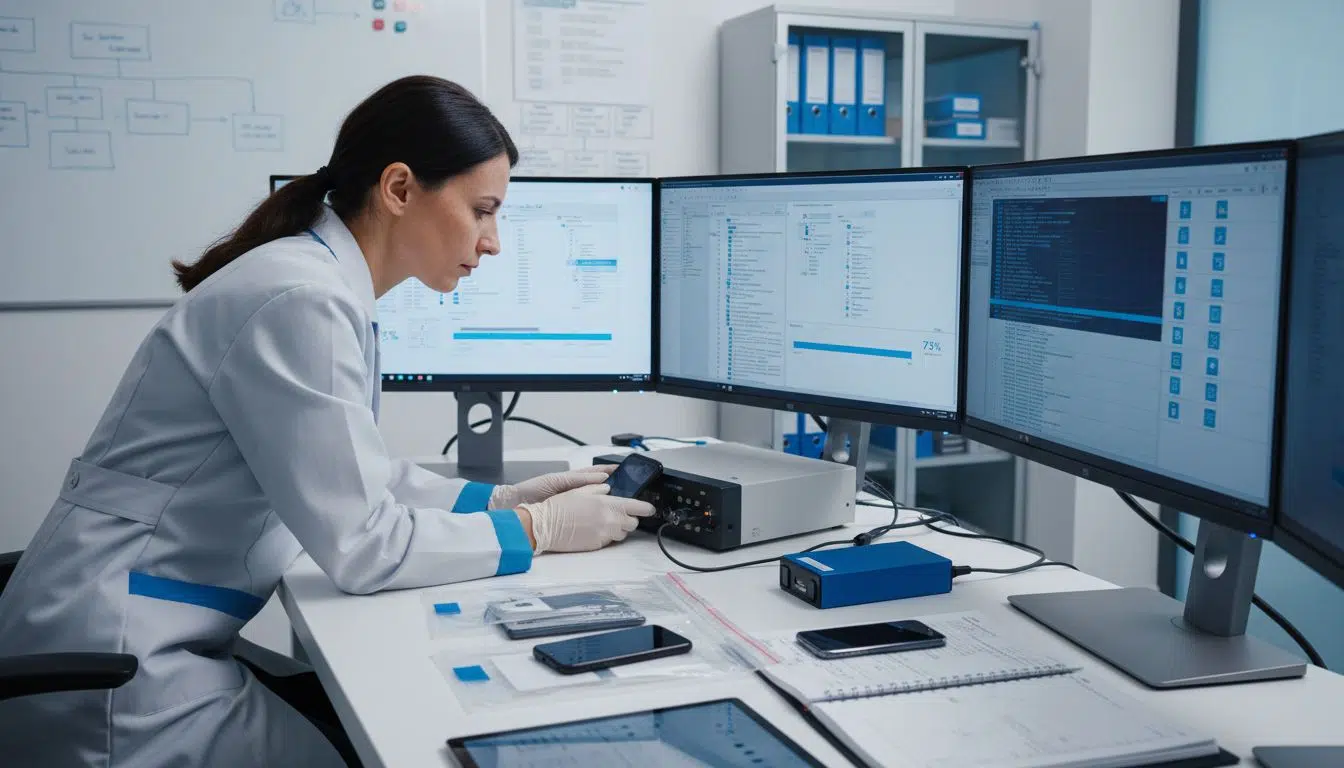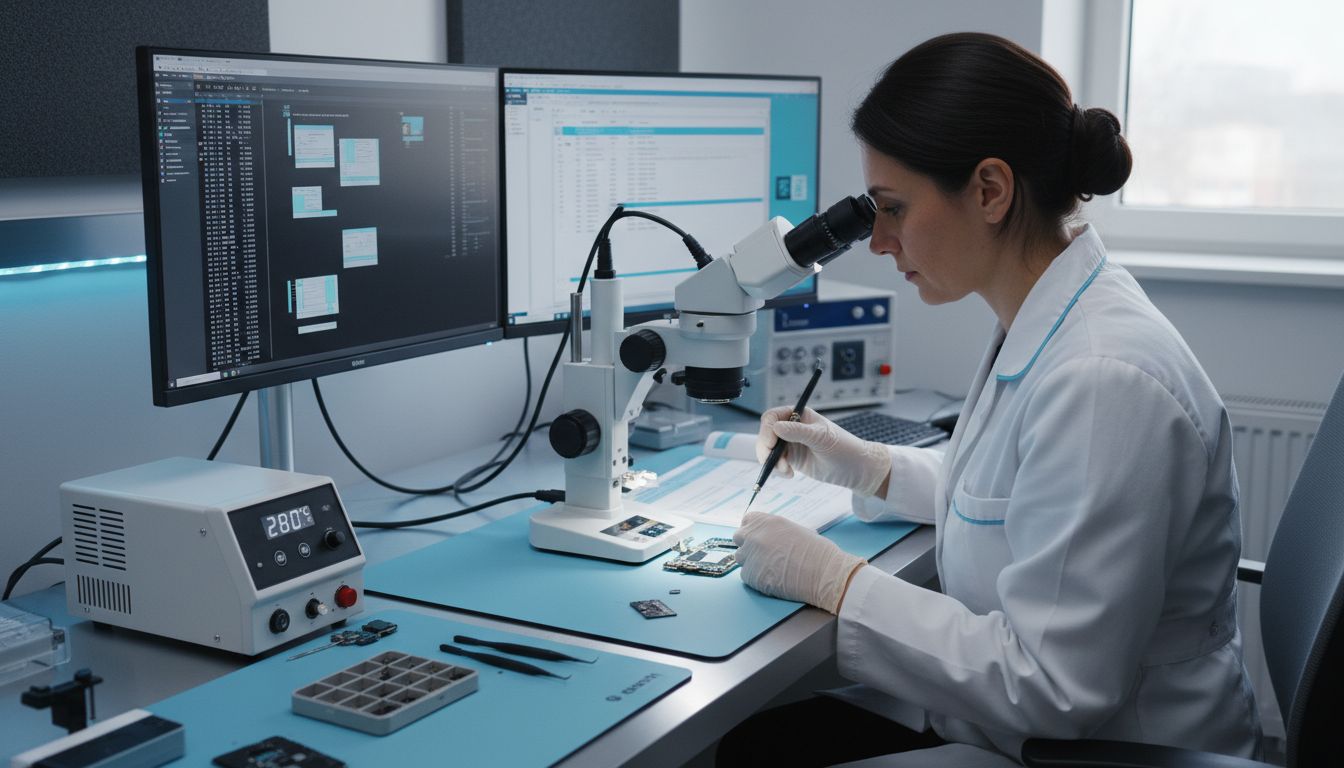Did you know that over 90 percent of people worldwide own a mobile phone? With so much personal data packed into these compact devices, they have become a goldmine for digital evidence in criminal investigations and legal disputes. Understanding how forensic experts extract, safeguard, and analyse this information is crucial when every text or call could make or break a case.
Table of Contents
- What Is Mobile Phone Forensic Examination?
- Types of Mobile Phone Forensic Methods
- Essential Tools for Forensic Analysis
- Legal Considerations in Mobile Forensics
- Best Practices for Evidence Preservation
- Challenges and Common Mistakes to Avoid
Key Takeaways
| Point | Details |
|---|---|
| Digital Evidence Recovery | Mobile phone forensic examination systematically recovers and analyzes digital evidence from mobile devices for legal purposes. |
| Extraction Techniques | Forensic methods include manual examination, logical extraction, physical extraction, and hardware forensics, each suited for different data retrieval scenarios. |
| Legal Compliance | Adhering to legal protocols is crucial to ensure the admissibility of evidence, with an emphasis on documentation and chain of custody. |
| Preservation Best Practices | Effective evidence preservation requires meticulous handling and strict adherence to protocols to avoid compromising the integrity of the data. |
What Is Mobile Phone Forensic Examination?
Mobile phone forensic examination is a specialised digital forensics discipline focused on systematically recovering, preserving, and analysing digital evidence from mobile devices like smartphones and tablets. According to research from the EC Council, this process involves extracting critical information such as deleted files, application data, GPS coordinates, call logs, text messages, and multimedia files in a legally admissible manner.
At its core, mobile forensics requires a meticulous approach that ensures digital evidence remains intact and unaltered during the investigation. As outlined by GeeksforGeeks, the process encompasses several critical stages:
- Device seizure: Carefully securing the mobile device
- Isolation: Preventing remote data wiping or network interference
- Identification: Mapping potential digital evidence locations
- Acquisition: Extracting data using forensically sound techniques
The primary objective of mobile phone forensic examination is to recover digital evidence that can be presented in legal proceedings. This might involve criminal investigations, corporate misconduct cases, or civil litigation scenarios. Mobile Phone Forensics: The Core Principles and How It Works provides deeper insights into the intricate methodologies used by digital forensics professionals to uncover crucial digital traces while maintaining strict chain of custody protocols.
Types of Mobile Phone Forensic Methods
Mobile phone forensic methods are diverse and sophisticated, designed to extract digital evidence through various technical approaches. According to research from the InfoSec Institute, these methods can be categorised into three primary extraction techniques: manual examination, logical extraction, and physical extraction. Manual examination involves directly browsing the device’s content, while logical extraction accesses data through the device’s operating system, retrieving user files and system information.
Physical extraction represents the most comprehensive forensic method, involving creating a bit-by-bit copy of the device’s entire storage. This technique allows forensic experts to recover deleted files and access data not typically retrievable through standard logical methods. Mobile Phone Physical Data Extraction and Recovery in Digital Forensics Examinations provides deeper insights into these advanced extraction techniques.
Hardware-based forensic methods offer additional sophisticated approaches for challenging scenarios. Research from Salvation Data highlights three critical hardware techniques:
- JTAG forensics: Accessing device memory through test access ports
- Chip-off forensics: Physically removing and extracting data from memory chips
- Bootloader exploitation: Leveraging vulnerabilities in the device’s bootloader to gain memory access
These methods are particularly valuable when dealing with damaged devices or when standard extraction techniques prove ineffective, providing digital forensics professionals with robust tools to recover critical digital evidence.
Here’s a comparison of the main mobile phone forensic extraction methods:
| Method | Data Accessible | Use Cases |
|---|---|---|
| Manual Examination | Visible on device Basic user data |
Quick checks Minimal resources |
| Logical Extraction | User files Contacts System info |
Routine investigations Standard cases |
| Physical Extraction | Entire storage Deleted files Hidden data |
Advanced recovery Damaged devices |
| Hardware Forensics | Raw memory Deep-level data |
Bypassing locks Chip damage |
Essential Tools for Forensic Analysis
Mobile forensic tools are sophisticated technological solutions designed to extract, preserve, and analyse digital evidence from mobile devices with precision and legal integrity.
Two prominent tools that have revolutionised digital forensics are XRY by MSAB and the Universal Forensics Extraction Device (UFED) by Cellebrite, each offering unique capabilities for investigators and legal professionals.
According to Wikipedia, XRY is a comprehensive digital forensics product developed by the Swedish company MSAB. This tool combines specialized hardware for device connection and advanced software for data extraction, supporting both logical and physical device examinations. Its versatility allows forensic experts to recover information from various mobile devices, including smartphones, GPS navigation tools, and tablet computers.
The 8 Essential Mobile Forensics Tools List for Legal Experts highlights the critical nature of selecting the right forensic tools. The UFED by Cellebrite stands out as another pivotal tool in mobile forensics. As documented, this Israeli-developed device enables law enforcement agencies to:
- Unlock mobile devices across different operating systems
- Extract comprehensive data from iOS and Android platforms
- Support complex forensic investigations with robust extraction capabilities
These advanced tools represent the cutting edge of digital forensic technology, providing investigators with powerful means to uncover critical digital evidence while maintaining the strict legal and technical standards required in modern forensic examinations.
Legal Considerations in Mobile Forensics
Mobile forensics operates within a complex legal landscape where technical precision must be balanced with rigorous legal standards. The extraction and analysis of digital evidence demand meticulous attention to legal protocols to ensure the admissibility and reliability of gathered information in judicial proceedings.
According to the National Institute of Standards and Technology (NIST), forensic methods must be carefully validated to produce accurate and trustworthy results, especially when dealing with damaged mobile devices. This validation is critical because the extracted data may ultimately serve as evidence in court, requiring an unimpeachable chain of custody and forensically sound acquisition techniques.
Comprehensive Mobile Device Forensics Guide for Digital Forensic Experts highlights the intricate privacy and legal challenges inherent in mobile forensics. Research from the Electronic Frontier Foundation underscores the sensitive nature of forensic tools, which can access deeply personal information about an individual’s communications and activities. Key legal considerations include:
- Ensuring strict compliance with privacy regulations
- Obtaining appropriate legal authorisations before data extraction
- Maintaining comprehensive documentation of forensic processes
- Protecting individual rights during digital evidence collection
- Preserving the integrity of extracted digital evidence
Forensic professionals must navigate these legal complexities with the utmost care, recognising that their work bridges technical expertise and legal accountability, ultimately serving the pursuit of justice while respecting individual privacy rights.
Best Practices for Evidence Preservation
Digital evidence preservation is a critical process that demands meticulous attention to detail and strict forensic protocols. According to research from GeeksforGeeks, the mobile forensic process involves a strategic approach to collecting and protecting digital information, ensuring its integrity and legal admissibility.
The fundamental stages of evidence preservation begin with device seizure and isolation. This crucial initial step prevents potential remote data manipulation or unauthorized access. As outlined by the InfoSec Institute, forensic professionals must immediately implement protective measures that block network connections, prevent device wiping, and secure the physical device to maintain its evidentiary value.
Understanding Chain of Custody Procedures in Law highlights the intricate documentation required in forensic investigations. Best practices for evidence preservation include:
- Creating comprehensive documentation of device handling
- Maintaining unbroken chain of custody records
- Using write-blocking technologies during data extraction
- Generating forensic duplicates without modifying original data
- Implementing strict access controls for evidence storage
- Documenting every interaction with digital evidence
Forensic experts must approach evidence preservation with scientific precision and legal rigor, recognising that the smallest procedural misstep could compromise an entire investigation’s credibility and potentially render critical evidence inadmissible in legal proceedings.
Challenges and Common Mistakes to Avoid
Mobile device forensics is a complex field fraught with technological and procedural challenges that can quickly derail an investigation if not handled with exceptional expertise. According to research from the EC Council, the rapidly evolving landscape of mobile technologies presents forensic professionals with a constantly shifting technological terrain.
The National Institute of Standards and Technology (NIST) highlights the significant obstacles encountered when extracting data from damaged mobile devices. Physical challenges such as non-functional devices or compromised data ports require advanced hardware and software techniques to access memory chips directly. Critical validation of these extraction methods becomes paramount to ensure the reliability and legal admissibility of recovered evidence.
Essential Digital Evidence Preservation Methods for 2025 emphasizes the importance of understanding potential pitfalls. Common mistakes that can compromise a forensic investigation include:
- Failing to properly isolate devices from remote access
- Neglecting to use validated forensic tools
- Insufficient documentation of forensic processes
- Overlooking device-specific encryption challenges
- Inadequate understanding of diverse operating systems
- Improper handling that might alter or contaminate digital evidence
Forensic professionals must approach each investigation with meticulous attention to detail, recognising that a single procedural misstep can render potentially crucial evidence inadmissible, potentially undermining entire legal proceedings.
Unlock the Full Potential of Mobile Phone Forensic Examination
Navigating the complex challenges of mobile phone forensic examination requires expert knowledge and precise techniques to recover critical digital evidence while ensuring legal integrity. This guide highlights common obstacles such as device isolation, data extraction methods, and preserving the chain of custody—all of which demand specialised skills to avoid costly mistakes. Whether you are facing encrypted data issues, damaged devices, or strict privacy regulations, understanding these pain points is essential to protect your investigation’s credibility.
To overcome these hurdles and secure reliable digital evidence, trust the expertise of our Mobile Phone Forensic Experts at Computer Forensics Lab. Our team applies advanced forensic methods including physical extraction and hardware forensics backed by rigorous legal protocols. Explore how our dedicated Mobile Forensic Investigators can support your case with comprehensive mobile forensics investigations and expert witness services. Start safeguarding your digital evidence today by visiting computerforensicslab.co.uk to discuss your investigation needs with our specialists.
Frequently Asked Questions
What is mobile phone forensic examination?
Mobile phone forensic examination is a specialized digital forensics discipline that focuses on systematically recovering, preserving, and analysing digital evidence from mobile devices such as smartphones and tablets.
What are the main types of mobile phone forensic extraction methods?
The main types of mobile phone forensic extraction methods include manual examination, logical extraction, physical extraction, and hardware-based forensic methods like JTAG and chip-off forensics.
Why is legal compliance important in mobile forensics?
Legal compliance is critical in mobile forensics to ensure the admissibility and reliability of extracted digital evidence. This involves following strict privacy regulations and maintaining an unbroken chain of custody throughout the forensic process.
What best practices should be followed for evidence preservation in mobile forensics?
Best practices for evidence preservation include securing the device to prevent remote access, documenting the device handling, maintaining a chain of custody, using write-blocking technologies, and implementing strict access controls during evidence storage.
Recommended
- Mobile Phone Forensics: The Core Principles and How It Works
- Exploring the Role of Mobile Phone Experts in Uncovering Key Evidence for Civil and Criminal Litigation
- Top Reasons Why Mobile Forensic Experts Are Essential in Today’s Investigations
- Forensic Engineering Process: Step-by-Step Investigation Guide – FloridaLicensedEngineers.com
- Why Fixing Phone instead of buying, Benefits | Dash Cellular

